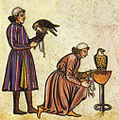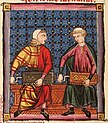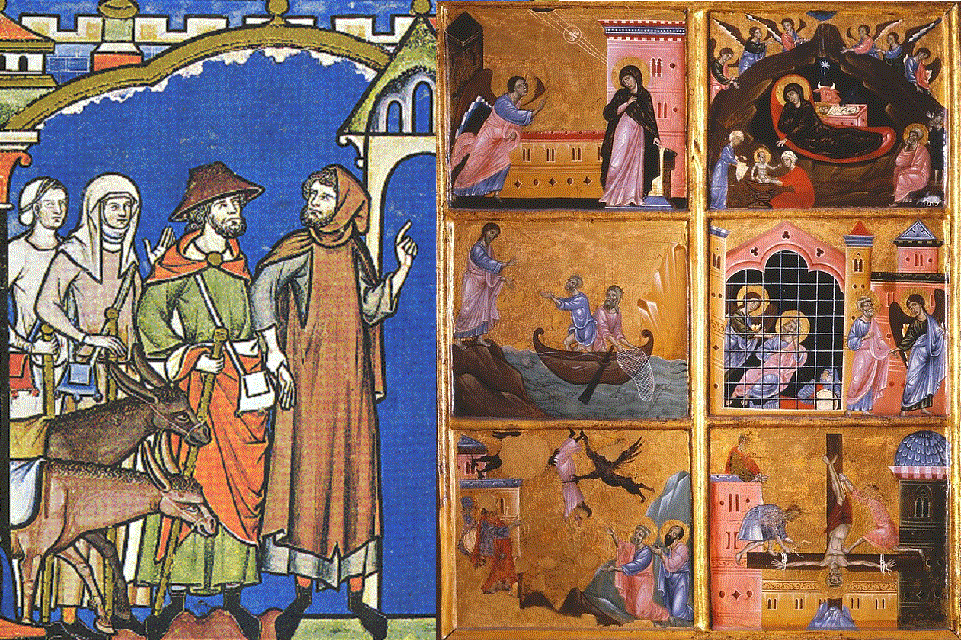Costume during the thirteenth century in Europe was very simple for both men and women, and quite uniform across the continent. Male and female clothing were relatively similar, and changed very slowly, if at all. Most clothing, especially outside the wealthier classes, remained little changed from three or four centuries earlier. The century saw great progress in the dyeing and working of wool, which was by far the most important material for outerwear. For the rich, colour and rare fabrics such as silk from the silkworm was very important. Blue was introduced and became very fashionable, being adopted by the Kings of France as their heraldic colour.
Features
With the development of social division of labor starting from the 12th century , craftsmen dedicated to handicrafts was born and technology such as sewing became high. Craftsmen formed a cooperative association that moved along the highway , around the big church , etc. and established an apprenticeship system that appointed apprenticeship system and mutual help system among same-occupational job categories, and custom production by guild began.
In the 13th century, the production of woolen fabrics became active in England , Normandy , Picardie , Champagne and so on, and the production of silk fabrics in Lyon also began. Kim Ryuko , taffeta and satin , velvet , crepe de soova (shrinking thin silk), camello (mixed with cashmere and silk) were popular as clothing. In addition, cotton is beginning to circulate at this time, and Futian weave of cotton and flax interweaving has also appeared.
As fashion consciousness by feudal lords increased, fur trading became vigorous. In addition to ten classes and squirrels popular from the previous era, badgers , rabbits, musk and rats, musk cats , beavers , lambs were sought as furs to wear around clothes collars and sleeves . The common people who can not use expensive fur also used furs such as sheep, goats , cats, etc. for the decoration of clothes. Here Western European fashion industry got into full swing.
Fabrics
The wool cloth produced in Flanders, linen and hemp were the basic materials for all social classes. But the precious fabrics from the East, the velvet and satin made in Italy, Genoa or Venice, the furs, also clothed the nobility and the rich bourgeoisie.
Dyes and mixtures of yarns of different colors allowed the appearance of a wide range of new colors. The fashionable colors were red, blue and green. Crimson and scarlet velvets and satins were colored by kermes , which was simply called the seed . More commonly, gaude , woad and madder were used which allowed a wide variety of colors.
We wore plain clothes but we did not hesitate to superimpose the bright colors, or to double the coats of a contrasting colored fabric. The crusades made known the silk, the damas , the muslins . We used a lot of cendal, a silk fabric that looked like taffeta. The culture of pastel enabled dyed blue for the first time the clothes and the color red dethroned as fashionable color when the kings of France have adopted for their color heraldic.
Men’s clothing
Men wore a tunic, cote or cotte with a surcoat over a linen shirt. One of these surcoats was the cyclas, which began as a rectangular piece of cloth with a hole in it for the head. Over time the sides were sewn together to make a long, sleeveless tunic. When sleeves and sometimes a hood were added, the cyclas became a ganache (a cap-sleeved surcoat, usually shown with hood of matching color) or a gardcorps (a long, generous-sleeved traveling robe, somewhat resembling a modern academic robe). A mantle was worn as a formal wrap. Men also wore hose, shoes, and headdress. The clothing of royalty was set apart by its rich fabric and luxurious furs. Hair and beard were moderate in length, and men generally wore their hair in a “pageboy” style, curling under at necklength. Shoes were slightly pointed, and embroidered for royalty and higher clergy.
Working men’s clothing
Working men wore a short coat, or tunic, with a belt. It was slit up the center of the front so that they could tuck the corners into their belt to create more freedom of movement. They wore long braies or leggings with legs of varying length, often visible as they worked with their cotte tucked into their belt. Hose could be worn over this, attached to the drawstring or belt at the waist. Hats included a round cap with a slight brim, the beret (just like modern French ones, complete with a little tab at the top), the coif (a little tight white hood with strings that tied under the chin), the straw hat (in widespread use among farmworkers), and the chaperon, then still a hood that came round the neck and over the shoulders. Apart from aprons for trades like smithing, and crude clothes tied round the neck to hold seed for sowing, special clothes were not worn for working.
Style gallery
 1 – Work clothes |
 2 – Shirt |
 3 – Tunics |
 4 – Tunics and mantles |
 5 – Cappa or chaperon |
|---|---|---|---|---|
 6 – Tunics |
 7 – Tunics with hanging sleeves |
1.Men working in linen braies, tunics, and coifs, from the Maciejowski Bible, c. 1250. The man on the left wears green hose over his braies.
2.Man in a coif and shirt (camisa) with gussets at the hem, from the Cantigas de Santa Maria, Spain, mid-13th century.
3.Falconers wear belted tunics and coifs, 1240s.
4.Young Merlin wears a short tunic with a rectangular cloak or mantle and hose. King Vortigern wears a mantle draped over both shoulders over a long overgown or tunic and shoes with straps at the instep. From a manuscript of Geoffrey of 4.Monmouth’s Prophetia Merlini, c. 1250–70.
5.Man in the short, hooded cape called a cappa or chaperon, c. 1250–70.
6.Musicians wear two long tunics, one over the other. The tunic on the left is an early example of mi-parti or particolored clothing, made from two fabrics. Cantigas de Santa Maria, mid-13th century, Spain.
7.Pan-pipe players wear tunics with hanging sleeves over long-sleeved undertunics. Both wear coifs. Cantigas de Santa Maria, mid-13th century, Spain.
Women’s clothing
Overview
Dress for women was modest and restrained, and a narrow belt was uniform. Over it was worn the ‘cyclas’ or sleeveless surcoat also worn by men. More wealthy women wore more embroidery and their mantle, held in place by a cord across the chest, might be lined with fur. Women, like men, wore hose and leather shoes.
Headdresses and hairstyles
Individuality in women’s costume was expressed through their hair and headdress. One distinctive feature of women’s headwear was the barbette, a chin band to which a hat or various other headdress might be attached. This hat might be a “woman’s coif”, which more nearly resembled a pillbox hat, severely plain or fluted. The hair was often confined by a net called a crespine or crespinette, visible only at the back. Later in the century the barbette and coif were reduced to narrow strips of cloth, and the entire hairdress might be covered with the crespine, the hair fashionable bulky over the ears. Coif and barbettes were white, while the crespine might be colored or gold. The wimple and veil of the 12th century still seen on nuns today was still worn, mainly by older women and widows.
Style gallery
 1 – From the Morgan Bible, c. 1250: the wifeof Manoah wears a veiland wimple. Note striped hose. |
 Two women – a symbol of “mercy” and “truth” ( 1220 – 1225 ) |
|---|
Sumptuary laws
The Fourth Council of the Lateran of 1215 ruled that Jews and Muslims must be distinguishable by their dress, beginning the process that transformed the conical or pointed Jewish hat from something worn as a voluntary mark of difference to an enforced one. Previously it had been worn but had been regarded by European Jews as “an element of traditional garb, rather than an imposed discrimination”. A law in Breslau in 1267 said that since Jews had stopped wearing the pointed hats they used to wear, this would be made compulsory. The Yellow badge also dates from this century, although the hat seems to have been much more widely worn.
Sumptuary laws covering prostitutes were introduced (following Ancient Roman precedent) in the 13th century: in Marseilles a striped cloak, in England a striped hood, and so on. Over time these tended to be reduced to distinctive bands of fabric attached to the arm or shoulder, or tassels on the arm.
These probably reflected both a growing concern for control over the increasing urban populations, and the increasing effectiveness of the Church’s control over social issues across the continent.
Footwear
Shoes began to develop a pointed toe at this time however, they were much more restrained than they were in the 14th century. The usual shoe for men opened at the front, from the instep to the toe. Commoners also wore stockings with leather sewn to the sole, and wooden clogs. Woollen garters were also worn by commoners.
 “Ashmor animal allegory” From the 14th tobacco (early 13 th century) |
 A variety of tunic and cloak, wears such as Judean hat and veil – Anonymous (From Levi and his wife to give inn to the town of Gibea) “(around the year 1250) |
 Duccio di Buoninsena”Virgin and Child of the Throne and Six Angels” ( around the year 1285 ) – Uffizi Gallery |
 Chimabu “Virgin and Child, St. Francis, St. Dominico and Two Angels” – Uffizi Gallery |
|---|---|---|---|
 Gido di Graziano “Peter” (13th century) – National Museum of Fine Arts of Siena |
 “Knocking on theEmperor BarbarossaSaxony PublicHeinrich Lion Public ” (late 13th century) |
Source from Wikipedia
